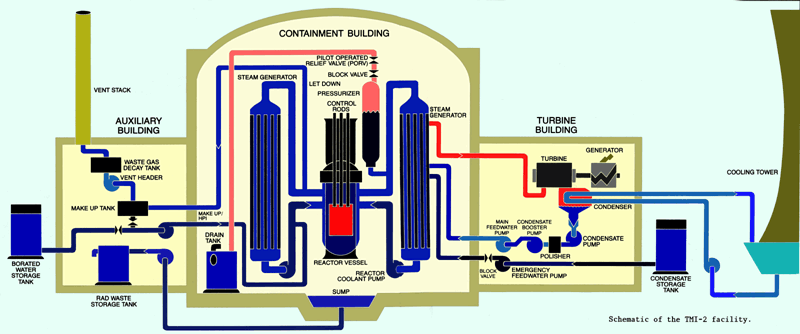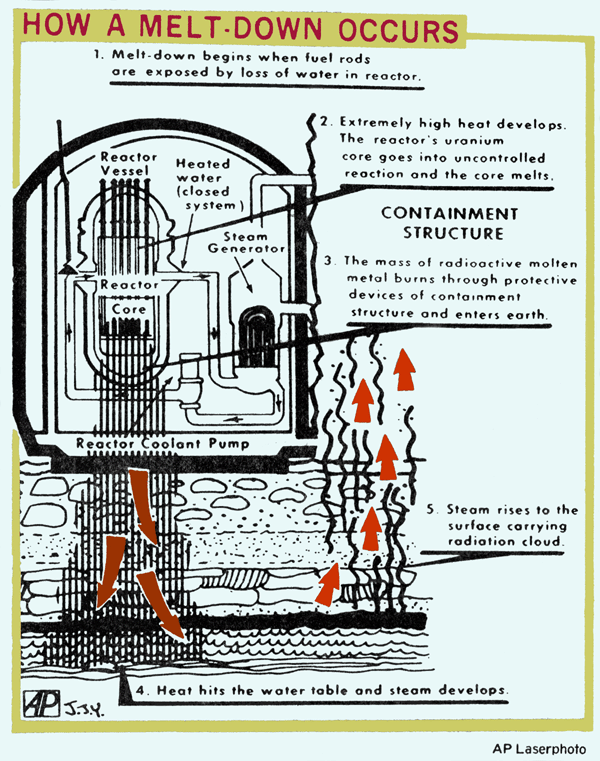
Meltdown: It can't happen here, they say...
Until March 28th, 1979, the nuclear industry assured the American public that there was no way a meltdown would happen here. To make this assurance, they had to ignore the contrary evidence provided by past events.
This evidence includes the partial meltdown of the Enrico Fermi nuclear power plant. "We almost lost Detroit" was how an industry engineer described it, in a fit of lucidity unequaled since by any member of the Nuclear Mafia.
They also had to ignore an explosive fuel-handling error resulting in three deaths in Idaho (including one man impaled on the ceiling of the facility); and numerous other "near-misses".
But on March 28th, 1979, because of events which unfolded in Middletown, Pennsylvania, the nation's attitude towards nuclear power changed. Since that day, no nuclear power plants have been ordered in America. Numerous nuclear power plants were canceled or converted to other, far safer, fuel sources. However, over 100 American nuclear power plants still operate, as of this writing (2002).

-- Above image is from an ad run by Commonwealth Edison shortly after the accident (colorized by this author).
Three Mile Island's Unit II reactor had only been online since December of the year before. The reactor had first achieved criticality precisely one year before, to the hour. A valve became stuck in the open position. A valve stuck open is just like a pipe break or other failure which causes a constant radioactive coolant outflow and pressure loss. Therefore, it is equivalent to a "Small Scale LOCA" (Loss Of Coolant Accident). The nuclear industry never thought a Small Scale LOCA could end up like this!

-- Above image is from: Report of the President's Commission on the Accident at Three Mile Island: The Need for Change: The Legacy of TMI, John G. Kemeny, Chairman, (Bruce Babbitt also signed the document, with 10 others), pages 106-107, October, 1979 (colorized by this author).
A series of human errors quickly compounded the problem. The fuel assemblies were partially uncovered and some melting occurred, along with a lot of oxidation of the zirconium fuel cladding.
The reactor was destroyed, although it took the owners several years before they admitted that it would never be restarted. All new reactor licenses were held up for a year while the accident was investigated, but currently operating reactors -- even the ones with virtually identical designs -- were not shut down as a precaution while the root cause was being determined. Such concern for safety over profits has never occurred in the Nuclear Mafia.
Large amounts of radiation were released, but exactly how much is unknown, because careful measurements intentionally and unintentionally (equipment failures) were not made. Thousands of people were evacuated, and the media had a field day, or field week, as the case turned out.
After Three Mile Island, the opposition forces were accused of being well-funded -- to the tune of $300,000,000.00 a year! This claim was utterly preposterous, but there was nothing else left to accuse them of (and the Nuclear Mafia had to accuse them of something). The dire warnings from nuclear power's many knowledgeable opponents had been verified. They had not been exaggerating or trying to unjustly scare anyone. They were simply telling it the way it is.
Coincidentally, a movie about a similar event had just come out, called The China Syndrome ("China Syndrome" is another name for a meltdown). In the movie, a meltdown is described, correctly, as being capable of destroying an area the size of Pennsylvania (thousands of square miles).
---------------------------------
Below is a drawing which appeared while the incident at TMI was still going on, and the potential for disaster on an unparalleled scale was only starting to subside.

-- The above image is from: The Bridgeport (Connecticut) Post, March 31st, 1979 (adapted for the Internet and colorized by this author).
A meltdown can happen at any nuclear reactor at any time.
After Three Mile Island, every other reactor and every other country explained why such an accident could not happen there. This included the Russians, Germans, English, French, and others. Of course, the Russians were proven wrong just seven years later, when Chernobyl suffered a much more serious partial core meltdown.
After Chernobyl, every other reactor and every other country explained why such an accident could not happen there.
In April, 2002, a hole in the top of the Reactor Pressure Vessel (RPV) of the Davis-Besse reactor in Ohio proved that it can happen here, and it unquestionably WILL happen here sooner or later. At Davis-Besse, nearly 900 pounds of steel had been eaten away in two separate holes in the RPV head. All that was stopping a catastrophic LOCA was about 1/8th inch of stainless steel -- the inner liner, which was only there to prevent the very type of corrosion that had occurred from leaks on the opposite side -- the inner liner was NOT designed to hold back the 2200 PSI, 650 degrees Fahrenheit pressurized water inside the reactor! Luck was with a lady named Besse that day, but America's luck WILL run out -- because technology based on luck is a fool's paradise.
---------------------------------
We really did almost lose Detroit -- and most of Michigan with it. We also almost lost Ohio, Pennsylvania, and Idaho, too.
Will YOUR state be next?
Will it be another "almost"?
---------------------------------
Copyright (c) 2002 by Russell D. Hoffman. All Rights Reserved